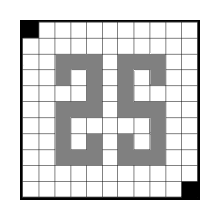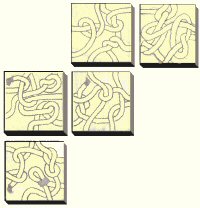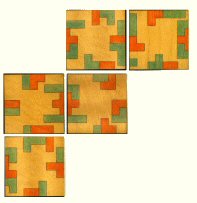
By 1986 we were pretty confident that we had figured out what we were doing and how to do it. We were doing lots of shows, including time travel to fantasy worlds like science fiction conventions and the Maryland Renaissance Festival. We had a nice repertoire of puzzles and games, with more ideas waiting in the wings than we could handle.
We developed new styles and expansions for some of our established products, and got guts enough to make the huge Heptominoes and nuts enough to build a Hexacube. Here are their stories in brief.
 Octiles® — (reloaded) Octiles® — (reloaded)
Two years after Octiles captivated the world, its inventor, Dale Walton, wanted to add a third game version. "Move Over" was a delight, a simplified format easy to teach and quicker to play. It's the only version we now explain. Advanced players can still enjoy the more complicated formats. The current rule book incorporates all three game variations and 29 solitaires.
 Pyramid Puzzles, deluxe Pyramid Puzzles, deluxe
Three styles and sizes of ball pyramid puzzles were invented around 1971 by Leonard Gordon, who also built the molds to make the pieces in polystyrene. Len and his brother, Jerry, founded a company, Gordon Bros., to manufacture and market an extensive product line of puzzles. Kate met Len in 1982 at a puzzle party and added a Gordon Bros. showcase to the Kadon catalog.
Len had a large stash of unassembled pyramid parts and bases, and in 1984 we acquired those as well, doing our own assembly and later specializing in crystal balls only, making our own bases when Len's original black plastic bases ran out in 1986.
When Len Gordon retired, he sold his remaining stock, tooling and customer base (including Kadon) to furniture maker Gerry Gonsalves. Gerry was stalwart in keeping crystal pieces in stock for us all these years, even after he in turn retired and closed the puzzle business. In 2016 Gerry ran out of pieces and disposed of the old molds as scrap metal, and that was the end of an era.
In 2017 we, too, ran out of pieces, and the Giant Pyramids vanished; only a half-dozen Perplexing Pyramids remained. In that year, with the end in sight, we used up the last unmatched bunch of spare parts in one-of-a-kind square-based order-4 pyramids of 30 balls each, patching together whatever worked in a small collection of a dozen or so Potluck Pyramids, reprising the shape of the previously extinct Big pyramid. Finally, we dumped the few remaining pieces, in mixed colors, into three order-5 tetrahedra shaped like the vanished Giant but with all-different groupings of 35 balls that we jokingly called "Franken-5" pyramids. Goodbye, Gordon Bros. pyramids. May you live on happily ever after in puzzle collectors' troves.
Postscript: In 2019, we ran out of parts for a related ball pyramid ensemble, Warp-30, and we bid farewell to another beautiful collector's item.
 Kolossal Pyramid Kolossal Pyramid
Another of Len Gordon's brain bursts, the Kolossal Pyramid used just 12 pieces: 8 of one kind and 4 of another, to build an order-6 tetrahedron. We crafted deluxe wood platforms for it, to match the new wood bases we had just introduced for all the other pyramids. Len had thought there might be only one solution, but we found several. And then our dear customer, Gordon Collins, did a full analysis of the "Kompleat Kolossal": 47 solutions. Disenchanted with so "easy" a puzzle, Len discontinued making one of the components. Goodbye, Kolossal.  For a very short time we did make them out of 56 wooden balls laboriously pegged together, and those have been out of print for many years. Oh, man, they were a thing of beauty. For this silver anniversary year, though, we have made a limited edition of exactly five wooden Kolossal Pyramids. They were priced at $125 each during 2011 only. As of December 2, 2011, the Silver edition sold out. In 1995 we finally gave the wooden Kolossal a permanent home as a custom order only, one at a time, at $150. For a very short time we did make them out of 56 wooden balls laboriously pegged together, and those have been out of print for many years. Oh, man, they were a thing of beauty. For this silver anniversary year, though, we have made a limited edition of exactly five wooden Kolossal Pyramids. They were priced at $125 each during 2011 only. As of December 2, 2011, the Silver edition sold out. In 1995 we finally gave the wooden Kolossal a permanent home as a custom order only, one at a time, at $150.
 Memory BankTM — (revisited) Memory BankTM — (revisited)
To please both kinds of players—number lovers and word lovers—Memory Bank's inventor, Barbara Ungar, and Kadon got together to expand the game with a word-solving feature, played on the same board. All we had to do was to make letters, one full alphabet for each player, die-cut in rigid vinyl in cheerful green. The word game was exciting because it allowed the players to collaborate, and its guess-and-feedback system was reminiscent of the mass-market hit, Mastermind. As of 2011 there are only a very limited number of these sets remaining. They are officially out of print and out of stock except for a few archival sets. First come, first served.
 Poly-5TM Poly-5TM
Having produced the original Quintillions set as three-dimensional wood blocks of the 12 shapes of 5 cubes each, we followed it up in 1984 with a compact two-dimensional acrylic set of all the shapes of six squares joined: Sextillions. More and more we now felt the need for a companion set of all the smaller polyominoes size-compatible with Sextillions. Why didn't we think of making them sooner? Because Quintillions had just got a little companion set, the wooden Poly-4 supplement, in 1985. However, that was not a full-fledged product, more like a secret made only for special requests.
 The Poly-5 ensemble was a winner from the start, with a 52-page booklet of good stuff—lots of puzzles and 6 games. Since the total area of all the polyominoes 1 through 5 is 89 unit squares (a prime number!), it took a bit of doing to find a symmetrical shape they could all fill that still fit within a square outline. Finally, the diagonal square with zig-zag edges worked. After 25 years it continues to be one of our top bestsellers. For their silver anniversary, we included a bonus challenge of filling a square with the number 25 embedded (shown at right). The Poly-5 ensemble was a winner from the start, with a 52-page booklet of good stuff—lots of puzzles and 6 games. Since the total area of all the polyominoes 1 through 5 is 89 unit squares (a prime number!), it took a bit of doing to find a symmetrical shape they could all fill that still fit within a square outline. Finally, the diagonal square with zig-zag edges worked. After 25 years it continues to be one of our top bestsellers. For their silver anniversary, we included a bonus challenge of filling a square with the number 25 embedded (shown at right).
Footnote: Several years later, someone else's mass-produced game, Blokus, used the same 21 shapes and even based their game on our original theme of pieces touching at corners only. Players quickly learn our secret mantra: Put the big pieces in first.
 Super Roundominoes® Super Roundominoes®
Expanding on the success of our irresistible little Roundominoes, the search for bigger, more complicated shapes found the Super Roundominoes set. After more than a year of concerted research, Kate was still dubious about publishing it... because it was way too hard! Still, it was too beautiful not to. It's one of the most eye-catching pieces in our booth and has become one of our consistent bestsellers. A few of the hardest questions went unsolved, as a challenge to the world at large. Be the first to solve one of those and win a prize. For its 25th anniversary year, we're making a limited number of them with frosted silver-tone frames! Request it on your order form.
 Heptominoes Heptominoes
Bigger yet — if Sextillions has all the shapes of 6 squares joined, what would 7 squares look like? We came across a magnificent solution by David Klarner of the 108 shapes as three matching rectangles. With the luminous Lucite material we've been able to obtain, the pieces look sharp and clear, easy to distinguish. A reversible lid keeps the pieces in and dust out, even on a display stand. We decided to publish this set in a moment of bravado, without instructions. That has not discouraged avid seekers from finding amazing solutions and combinations. An increasing number of Internet sites have good material about the larger polyominoes these days, but no one else makes the physical set. Approach at your own risk.
 Hexacube Hexacube
We went for broke with the biggest, most complicated member of the polycube family, the 166 shapes of 6 cubes each. It includes not just the 35 flat (Sextillions) shapes, but all the 3D cubes piled on multiple levels. An unbelievable amount of work is involved in forming each piece, and sometimes it has taken us a year to finish an order. The treasure-chest-like wood box it packs into is hinged and folds out to one of the 11 flat hexomino shapes that can form a cube. With the full set, you have all the parts you need to build smaller figures and explore special subsets. The Hexacube is the most audacious of our polyform family. In working out what all the shapes were, Kate also came up with an easy-to-visualize naming system that has been published in the Journal of Recreational Mathematics. We do wish we had taken a photo of the 2x3x166 block that ran across the office floor, out the door and halfway down the hallway, impeding foot traffic for several days.
 Fractured FivesTM Fractured FivesTM
 Kate thinks this is one of her best designs ever. It started out as five squares cut from paper, with "ropes" tangling on one side and partial pentominoes on the other side, straddling the four edges. The goal is to form any of the 12 pentominoes such that images match on joined edges. For hardy solvers, one rope will be continuous across all five tiles. Kate thinks this is one of her best designs ever. It started out as five squares cut from paper, with "ropes" tangling on one side and partial pentominoes on the other side, straddling the four edges. The goal is to form any of the 12 pentominoes such that images match on joined edges. For hardy solvers, one rope will be continuous across all five tiles.
 The other sides of the 5 squares display partial pentominoes which, when correctly joined, show complete pentominoes across all joined edges. Advanced solvers will not have any duplicate shapes, and the P-pentomino will show a panorama of all 12 pentominoes. The other sides of the 5 squares display partial pentominoes which, when correctly joined, show complete pentominoes across all joined edges. Advanced solvers will not have any duplicate shapes, and the P-pentomino will show a panorama of all 12 pentominoes.
The ultimate challenge starts with the I-pentomino and asks the puzzler to form a sequence of all 12 pentominoes in 12 steps by moving one square at a time to a new position, with correctly matched edges, ending with the starting shape. Do this for both sides! If you solve such a sequence, send it to us. A new answer wins a prize.
Photocopied paper versions of this set became gifts for the 20 other guests at the first Puzzle Party Kate ever attended, then in its infancy in the gracious home of world-famous puzzle collector, Jerry Slocum. In the 25 years since, the event has grown to hundreds of attendees and takes place in large hotels across the globe.
This 25th year of Fractured Fives' design seemed a good time to share this versatile puzzle with the rest of the world, engraved on handfinished wood blocks with handpainted accents. About 50 cool challenges are included, some requiring heroic efforts at solving. This was no doubt the longest run-up between creation and publication in our product line.
This year we became courageous about venturing into more complex realms, expanding our existing sets, and boldly going where few if any had gone before in offering the world great and glorious challenges. Seeing the world large and not shrinking from big challenges became our fifth rule.
Prequels:
A Quarter-Century Retrospective (1980-2005)
1982-2007: The first wave of growth
1983-2008: The lesson of quality
1984-2009: Some things old, some things new
1985-2010: Guests and clones
You are here:
1986-2011: Thinking big... and bigger
Sequels:
1987-2012: Growing three ways
1988-2013: Compounding complexity
1989-2014: Grand visions
1990-2015: Herculean heights
1991-2016: Happy marriages
1992-2017: Diamonds forever
1993-2018: Opulence in acrylic and wood
1994-2019: Angles, gold and gala
1995-2020: Tilting towards tilings
1996-2021: Gorgeous geometrics
1997-2022: Big and little
1998-2023: Boards and beauties
1999-2024: Finding kindred spirits

|

